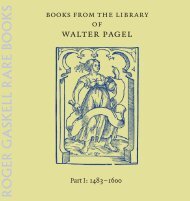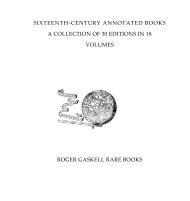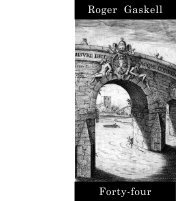pdf - Roger Gaskell Rare Books
pdf - Roger Gaskell Rare Books
pdf - Roger Gaskell Rare Books
You also want an ePaper? Increase the reach of your titles
YUMPU automatically turns print PDFs into web optimized ePapers that Google loves.
Fludd’s earlier work, Medicina Catholica (1629) contained the Wrst recognition<br />
in print of Harvey’s discovery of the circulation, though it has been questioned<br />
whether he really understood the physiological basis of the discovery.<br />
Nonetheless, Harvey himself, who was a close friend, commented on Fludd’s<br />
anatomical knowledge and Fludd reports in the present work that he had<br />
dissected the body of a hanged man privately in his own house in preparation<br />
for his anatomical lectures at the College of Physicians (Pagel p. 114).<br />
According to Manly Hall, Fludd here ‘extrapolates Mosaical truth. The<br />
central principle is that of systole and diastole, rarefaction and condensation,<br />
expansion and contraction. This is in essence the paradigm of microcosm and<br />
macrocosm central in much of the Western tradition of occult writing. Fludd,<br />
however, applies this idea directly to the occult truth of such phenomena as<br />
snow, fountains, wind, and the loadstone. He also discusses sympathetic cures<br />
in the Responsum.’ (Hoggart, p. 76.)<br />
The second work is a reply to William Foster, Hoplocrisma-Spongus: or, a<br />
sponge to wipe away the weapon salve (London, 1631), in which Foster accused<br />
Fludd and others of witchcraft.<br />
Walter Pagel, William Harvey’s Biological Ideas (1967), ‘Harvey and Robert Fludd’,<br />
pp. 113–119; Manly P. Hall, ed. Ron. Charles Hogart, Alchemy. A Comprehensive<br />
Bibliography of the Manly P. Hall Collection (1986).<br />
59<br />
FOREEST, Pieter van (1522–1597); James HART (d. 1639)<br />
The arraignment of urines wherein are set downe the manifold<br />
errors and abuses of ignorant urinemongring empirickes, cozening<br />
quacksalvers, womenphysitians, and the like stuVe... Collected and<br />
gathered as well out of the most ancient, as the moderne and late<br />
physitians of our time: and written Wrst in the Latine tongue, and<br />
divided into three bookes by Peter Forrest D. in Physicke, and native<br />
of the towne of Alcmare in Holland. And for the beneWt of our British<br />
nations newly epitomized, and translated into our English tongue by<br />
James Hart Dr. of the foresaid faculty, and residing in the towne of<br />
Northampton.<br />
London: Printed by G. Eld for Robert Mylbourne, and are to be sold at his<br />
shop at the great south doore of Pauls, 1623.<br />
4to: 4<br />
* (–* 1, blank) A4 a4 B–Q4 , 71 of 72 leaves, pp. [22] 122 (i.e. 120,<br />
113–4 omitted). Typographic headpieces, woodcut initials.<br />
165 x 125mm. Cropped at head and foot with loss of most of imprint<br />
and many headlines, catchwords and signatures partially or wholly lost.<br />
Binding: Eighteenthcentury half sheep over marbled boards, marbled<br />
endleaves. Worn, upper board detached.<br />
First edition, an abridged translation of Foreest, De incerto, fallaci,<br />
urinarum judicio (1589). Entered in the Stationer’s Register 7 January<br />
1623. STC 11180; ESTC S102442; Manchester 868.<br />
This was the Wrst work published by James Hart, abridged from Foreest’s







